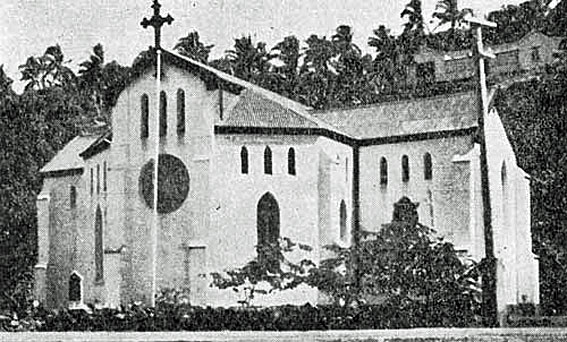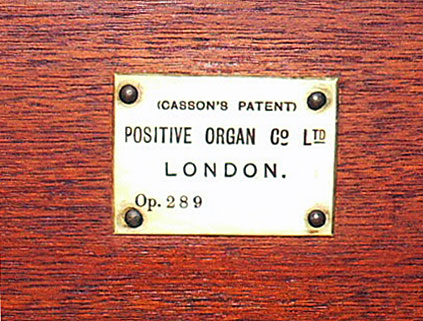
St Andrew's Anglican Church, Aberfeldie: exterior of church
[photograph by John Maidment (18 November 2014)]]

St Andrew's Anglican Church, Aberfeldie: exterior of church
[photograph by John Maidment (18 November 2014)]]
Historical and Technical Documentation by John Maidment
© OHTA (last updated November 2014)
The foundation stone of St Andrew's Church was laid on 15 May 1926 by the Most Revd Harrington Clare Lees, Archbishop of Melbourne. The architect was J.W. Hurst and the builder F. Fanning. It is constructed in brick in a simplified Gothic idiom.1

Church of the Holy Redeemer, Levuka, Fiji: exterior of church
[image from Google images]
The organ was built for the Church of the Holy Redeemer, a building opened in 1904, at Levuka which is a town on the eastern coast of the Fijian island of Uvalau and formerly the capital of Fiji.2 This was an elaborate architect-designed building in the Gothic style with fine stained glass. A reed organ was used at the opening of the church, so the pipe organ must have arrived shortly afterwards.

St Andrew's Anglican Church, Aberfeldie: organ viewed from the left
[photograph by John Maidment (18 November 2014)]
The organ was constructed by the Positive Organ Company Ltd, London as one of its standard models – opus 289, but with special casework constructed in mahogany and carefully carved, probably dating from around 1905. It would have been foot blown but there may have been provision also for hand blowing, the evidence for which has been removed.
The instrument was dismantled and shipped to Hill, Norman & Beard in Melbourne and sold to St Andrew's Anglican Church, Aberfeldie where it was installed in 1963. The pedal board is a later addition, made in blackwood and possibly cut down from a Fincham original, with a new plywood knee panel and recycled Fincham bench. The original transposing mechanism has also been removed; the keyboard begins at EE but the bottom note is no longer functional The organ incorporates spotted metal pipework and the case towers are capped by cornices – possibly to match its original location at Levuka. The Pedal Bourdon is without any stop control and appears to incorporate the pipes for an independent Double Bass 16, which would have played the bottom note of a chord in the left hand through a pneumatic mechanism. There is also one additional plugged in stop hole at the console, maybe for a Melodic Diapason; this has been removed. The treble Diapason pipes are placed on a separate chest at the rear, activated though wooden squares and controlled through a ventil. Hill, Norman & Beard also replaced internal trunking in flexible ribbed metal and recovered the keyboard, probably removing the original tropic-proof ivories. The console woodwork may also have been modified when the transposing mechanism was removed.
| MANUAL Open Diapason Salicional Gedact Bass Gedact Treble Dulcet Bass Dulcet Treble PEDAL [Bourdon] |
8 8 8 8 4 4 [16] |
bass in façade grooved bass to Gedact below TF; pipes tuned through slot and scroll to TB, canistered, metal Middle C up, canistered, metal to TB Middle C up permanently on, 20 notes – wooden pipes at sides from original melodic Double Bass 16 |
Compass: manual, FF-E 48 notes (EE provided for the transposing mechanism) / pedal FF-C 20 notes
Mechanical action to manuals, tubular-pneumatic action to pedals3
It has one additional rank (Salicional) compared with the earlier instrument by the same builder at St Luke's Anglican Church, Yea. The sound is exquisite, each rank having pronounced character, quick speech and brightness.
1 Information from foundation stone
2 http://en.wikipedia.org/wiki/Levuka accessed 18 November 2014
3 Details noted during visit by John Maidment 18 November 2014

St Andrew's Anglican Church, Aberfeldie: drawstops and keyboard
[photograph by John Maidment (18 November 2014)]

St Andrew's Anglican Church, Aberfeldie: nameplate
[photograph by John Maidment (18 November 2014)]

St Andrew's Anglican Church, Aberfeldie: detail of pipe tower - 1
[photograph by John Maidment (18 November 2014)]

St Andrew's Anglican Church, Aberfeldie: detail of pipe tower - 2
[photograph by John Maidment (18 November 2014)]

St Andrew's Anglican Church, Aberfeldie: treble pipes of the Open Diapason 8
and canistered pipes of the Gedact 8
[photograph by John Maidment (18 November 2014)]

St Andrew's Anglican Church, Aberfeldie: slotted pipes of Salicional 8, rear of façade pipes,
and rear of Pedal pipes
[photograph by John Maidment (18 November 2014)]